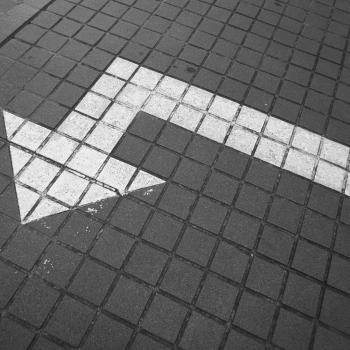Today I went to wash my hands in the restroom and discovered they moved the hand towel dispenser to the other side of the sink. I reached up to dry my hands and there was a sign hanging to the right of the sink, where the dispenser used to be. After a few seconds of confusion, I noticed it is now on the left side.
“Has that always been there?” I thought. It wasn’t until I repeated this entire pattern a second time that I realized it had been moved.
Our patterns are so ingrained in us that we do things without even thinking about it. Our System One is so finely developed that we tie our shoes and wash our hands subconsciously.

To a large degree, these patterns are the heart of who we are. It isn’t all paper towel dispensers and shoelaces. It is also things like defensiveness, anger, and entitlement. These patterns develop after years of repetition, miles of worn track, and the constant drumming of reinforcement.
The Challenge of Change
When we set out to change, it feels impossible. There is the great tide of our System One that propels us continuously in one direction. A direction we are familiar with. A pattern that has developed and, in some ways, has come to define us.
Change seems simple in our minds. Just do something different. But it is a monumental task. We have to transform our patterns in order to truly change.
If they hadn’t moved the dispenser in the bathroom, I likely would have never considered how patterned my behavior was. Our patterns are so ingrained they fade away, so prevalent they seem to disappear even as they determine our course.
Strain
Part of our System One is a life of little inconsistencies. We want to change but we don’t want to face the factors that bring change about. The only way to change is for our patterns to become strained.

We love the idea that we can blink and have everything happen anew. We love the idea of a clean slate, a restart. But our patterns are changed by hard work and consistent choices, not by a snap of the fingers.
We cannot suddenly adopt new patterns without the learning and evaluation that comes from straining our old ones.
Strain is the only way to change our patterns. We have to do something different and feel the tension trying to pull us back into the original patterns. One new action or idea is working against years of developed and reinforced patterns. Even the one new thing causes strain. The familiar and the comfortable patterns fight for their way. But for change to truly occur, more strain needs to be induced. One idea against the tide of established patterns is not enough. Two ideas is better. Three different choices better still. There is a tipping point somewhere along the way where our patterns break down and begin anew. But we will never get there until we live in the tension, the strain, and the difficulty of change.
New Patterns
Strain happens when we start to notice evidence that the patterns are not working for us. This invites us to consider different options. The more we consider different ways of living, the more likely we are to change. The more we make different decisions, the more we develop new patterns. We cannot get rid of patterns altogether; it is the way we were made. But we can, over time, replace unhealthy patterns with better ones.

It will take some time – maybe a week, a month, or a year – but, eventually, the dispenser on the left side of the sink will be a new pattern for me. One day soon I will go in there and not reach to the right; I’ll go automatically to the left and not even remember this blog or that I’m doing anything different than I used to.
Often, the same thing happens in our lives. Change is generally slow. It seeps into us. It transforms us through the monotony of consistency. New patterns are changed patterns. And change begins with strain.
Our world is trying so hard to avoid strain, at least when it comes to personal character. And, consequently, we’ve stunted growth. We don’t change. We don’t develop. We only reinforce what we have always been. Changing our patterns means leaning into strain as an opportunity for different choices.












